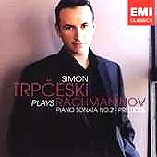Born in 1979, pianist Simon Trpceski first came to international attention at the London Piano Competition in 2000. While his solo debut disc for EMI garnered attention in Europe, it seemed not to have found its way to American critics, at least not to one writer who covers piano recordings for Classicstoday.com. By contrast, EMI appears to be beating the promotional drum on behalf of Trpceski’s follow-up effort, an all-Rachmaninov program. There’s no question of Trpceski’s potential for this beloved repertoire. He’s a real pianistic presence, whose virtuosic hands easily grasp Rachmaninov’s swirling passagework and thick chords. But when it comes to musicianship and interpretation, Trpceski is still a work in progress at this stage of his career.
For starters, his clunky, heavy-handed treatment of the G minor Prelude Op. 23 No. 5 transforms the composer’s taut march into an uphill climb in hot weather. For all the pretty sounds he makes in the D major Op. 23 No. 4 Prelude, Trpceski’s overshot climaxes and flaccid rhythm make the music sound rhapsodic and shapeless. Similarly, he becomes more excited than exciting as he approaches the dramatic high points of the F-sharp minor (Op. 23 No. 1) and G-sharp minor (Op. 32 No. 10) preludes.
Trpceski begins Rachmaninov’s Flight of the Bumble Bee transcription at a light-fingered clip that slows down within a few bars and rarely regains altitude, while the Mendelssohn Scherzo from A Midsummer Night’s Dream sounds decidedly less elfin than suppler, more effortless recent traversals from Friedrich Höricke (MDG) and Vladimir Ashkenazy (Decca), let alone the old Moiseiwitsch HMV shellac benchmark. However, Trpceski’s superbly structured performance of the C-sharp minor Prelude has tremendous concentration and an innate feeling of the music’s long line.
Perhaps the recital’s featured work, the B-flat minor Sonata (heard in Rachmaninov’s 1931 revision), most cogently demonstrates Trpceski’s strengths and limitations. On the plus side, he conjures up tremendous sonorities that never splinter or bang but rather contribute substantially to the visceral impact of the outer movement’s galvanizing passages. On the other hand, I often find his pianism bland and insufficiently varied in regard to articulation and texture. Compare the drier, more rhythmically incisive approach to downward runs served up by Horowitz or Weissenberg in the outer movements, or the aforementioned Höricke’s melodic definition in the slow movement, and you’ll understand my reservations. EMI’s roomy, slightly distant pickup does not match the warmth and presence of the label’s best piano recordings.
































